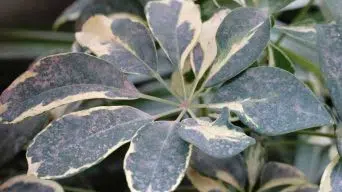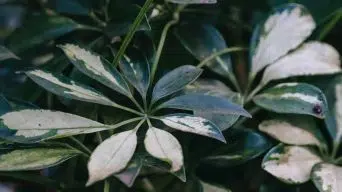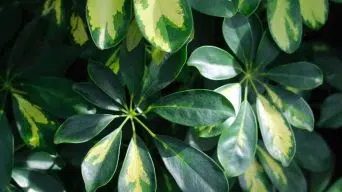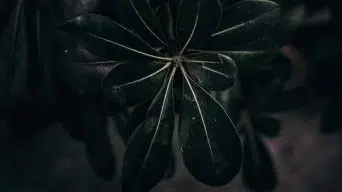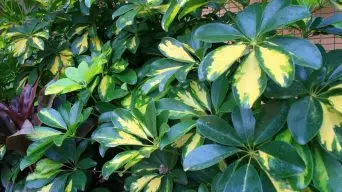Key Takeaways
- Understanding the factors that affect your Schefflera plant’s watering needs is crucial for maintaining healthy growth.
- Signs of underwatering or overwatering include wilting, yellowing leaves, root rot, and algae growth.
- Water your Schefflera once a week to every other week when the top inch of soil is dry, adjusting based on environmental factors like humidity and temperature.
- Practical watering tips include avoiding standing water, using a watering can instead of a hose, and checking soil moisture level with a moisture meter.
If you’re a proud owner of a beautiful Schefflera plant and want to keep it healthy, one of the critical aspects is understanding its watering needs.
Also known as Umbrella Trees or Dwarf Umbrella Trees, these tropical plants are beloved for their unique foliage and resilience, making them popular among indoor gardeners.
But how often should you water your Schefflera plant?
This guide will discuss factors affecting the watering schedule, signs of underwatering or overwatering, and tips on providing the perfect hydration for lush growth.
Factors Affecting Schefflera Watering Schedule
To determine how often you should water your Schefflera plants, consider key factors such as the type of soil, humidity levels, lighting conditions, container size and type, and climate.
These elements all play a crucial role in determining the watering schedule for your plants.
Type Of Soil
The type of soil used plays a crucial role in determining the watering schedule for your Schefflera plants.
These hardy, tropical plants thrive best in well-draining, sandy loam soil when grown outdoors or a rich, loose potting mix if cultivated indoors.
It is essential to choose the correct soil because different soils have varying water-holding capacities and drainage abilities.
For instance, clay-rich soils retain more water than sandy loams, leading to potential over-watering issues with your Schefflera plant.
Consider humidity levels and temperature when choosing the appropriate soil type for your indoor or outdoor growing environment.
Humidity Levels
Humidity plays a significant role in the overall health of your Schefflera plant, as these tropical plants thrive in environments with at least 60% humidity.
Indoor spaces often lack the necessary moisture levels, causing your plant’s leaves to turn yellow or brown and eventually fall off.
Misting the leaves occasionally helps increase humidity around the plant by simulating its natural rainforest habitat.
Additionally, placing a tray filled with water and pebbles beneath the pot is another effective method for boosting surrounding air moisture content.
Water evaporates from the tray, creating a humid microclimate for your Schefflera.
Lighting Conditions
Schefflera plants thrive in bright, indirect light but can also adapt to medium light conditions.
Positioning your plant near a window that receives filtered sunlight or using sheer curtains to diffuse the intensity of the direct sun is ideal for maintaining healthy growth.
Additionally, rotating your Schefflera every few weeks promotes even light distribution, ensuring balanced growth and preventing the plant from leaning towards one side.
Monitoring your plant’s response to the lighting conditions is essential, as this significantly determines how often you need to water it.
Container Size And Type
Your Schefflera plant’s size and type of container can greatly influence its watering needs.
Generally, larger containers retain moisture longer than smaller ones, requiring less frequent watering.
However, this also depends on the type of soil used and the amount of light and heat present in its environment.
For example, suppose your Schefflera is potted in a small container with a well-draining soil mix placed under direct sunlight or warm temperatures.
In that case, it may require more frequent watering than one planted in a bigger pot with a slower-draining soil mix placed in indirect light conditions.
Climate
The climate in which your Schefflera plant lives will significantly affect how often you need to water it.
For example, if you live in an area with high humidity, the soil may remain moist for extended periods than in a drier climate.
In addition, temperature also plays a part – warmer temperatures can cause the soil to dry out more quickly and may necessitate more frequent watering.
It’s important to monitor your plant regularly and adjust its care as needed based on changes in weather patterns or seasonal shifts.
Signs Of Underwatering And Overwatering
It’s important to recognize signs of both underwatering and overwatering.
If Schefflera leaves are wilting and turning yellow, it may be a sign of underwatering.
On the other hand, overwatering can cause root rot, algae growth, and yellowing of the lower leaves.
Wilting
Wilting is a common sign of both overwatering and underwatering in Schefflera plants.
It occurs when the leaves become limp, fold inward, or droop down towards the ground.
If your Schefflera plant is wilting, it could indicate that you are not watering it correctly.
Overwatering can lead to root rot which causes oxygen deprivation in the roots and wilting, among other things.
On the other hand, if your plant is underwatered for too long, its tissues will dry out and result in wilting.
Yellowing Leaves
One of the most common problems Schefflera plant owners face is yellowing leaves, which can be a sign of overwatering and underwatering.
If you notice the older leaves at the bottom of your plant turning yellow, this is likely due to natural aging and cannot be prevented.
However, if you see newer leaves turning yellow or drying out before they should, it may indicate that your plant needs more or less water.
Overwatered plants will have yellow and dropped leaves, while underwatered ones will have brown and dropped ones.
Using a moisture gauge can help determine when to water your plant appropriately, striking a balance between keeping the soil moist without causing root rot.
Root Rot
One of the most common problems that Schefflera owners face is root rot.
This occurs when the roots are consistently exposed to excess water, leading to an environment where fungi and bacteria thrive, attacking and killing the roots.
To prevent root rot in your Schefflera plant, it’s important to ensure proper drainage by using well-draining soil and pots with adequate drainage holes.
Additionally, avoid overwatering your plant – only water it when the top inch of soil is dry.
If you suspect that your Schefflera has already developed root rot, reduce watering frequency immediately while ensuring it receives enough sunlight.
You may also need to consider repotting with fresh soil if you notice any darkened or blackened roots during the inspection.
Algae Growth
Algae growth is a problem that can occur with both underwatering and overwatering Schefflera plants.
When the soil remains constantly moist, it creates an environment for algae to grow, which can then compete with the plant for nutrients.
To prevent algae growth, it’s essential to balance watering enough to keep the plant healthy and allow time for the soil to dry out between watering sessions.
Using well-draining potting mix and containers with proper drainage holes can also help reduce standing water in the soil, which can promote algae growth.
How Often To Water Schefflera Plants
For Schefflera plants to thrive, it is essential to water them deeply when the top inch of soil is dry.
Depending on environmental factors, this usually occurs once a week to every other week.
Watering Frequency
The watering frequency for Schefflera plants largely depends on their environment.
Generally, you should water your Schefflera once every week, but make sure that the soil is dry to avoid overwatering.
However, more frequent watering may be necessary to keep the soil moist during hotter months or high humidity levels.
Establishing a consistent watering schedule for multiple Schefflera plants can be challenging since each one might have different needs depending on location and environmental factors.
To avoid under or overwatering your plant(s), regularly check soil moisture levels by feeling the top inch before deciding whether to water again.
Amount Of Water
It’s important to give your Schefflera plant the right amount of water to ensure it stays healthy.
A general rule of thumb is to water until the soil is moist but not soaking wet.
When watering your Schefflera, pour enough water into the pot until it comes out from the drainage holes at the bottom.
This will indicate that all areas of soil have been reached and moisturized.
Allow excess water to drain completely before returning it to its usual spot- standing water can damage roots and promote fungus growth.
Checking Soil Moisture Level
To determine when to water your Schefflera plant, regularly check its soil moisture level.
You can do this by inserting your finger about an inch deep into the soil.
If the soil feels dry, it’s time to water your plant.
You may also use a moisture meter to measure the soil’s moisture level accurately.
This tool allows you to avoid overwatering and under-watering your Schefflera by giving precise readings on how much water is in the potting mix.
Ensure you insert the probe deeply enough into the soil for accurate measurements.
Tips For Effective Schefflera Plant Watering
Here are some helpful tips for watering your Schefflera plant effectively:
Avoiding Standing Water
Avoiding standing water in the pot or saucer is crucial to prevent root rot and other problems.
Here are some tips to help you achieve this:
- Always ensure the pot has adequate drainage holes to allow excess water to drain.
- After watering, remove any excess water that accumulates in the saucer or container beneath the pot.
- Do not let the Schefflera plant sit in standing water for an extended period.
- Use a well-draining soil mix that allows water to flow freely, avoiding compacted soil that can lead to poor drainage.
- Adjust your watering frequency and schedule based on season, temperature, humidity levels, and lighting conditions.
Always check the soil moisture level before watering and adjust your routine as needed based on seasonal changes and other factors.
Using A Watering Can Instead Of A Hose
When watering your Schefflera plant, using a watering can instead of a hose can effectively maintain proper moisture levels.
A watering can allow for more precise and controlled watering, which helps prevent over-watering and avoids damaging the delicate roots.
Furthermore, watering can also enable you to take time with each plant and assess its specific needs before adding any water.
You’re less likely to waste water by unnecessarily drenching the leaves or soil.
Remember that overwatered Schefflera plants are susceptible to root rot and other issues caused by excess moisture.
Using A Moisture Meter
A moisture meter is a handy tool to have when it comes to watering your Schefflera plant.
It measures the soil’s moisture level, letting you know when it’s time to water or hold off.
Insert the metal probe into the soil and check the readings on the gauge.
Using a moisture meter helps prevent overwatering, which can lead to root rot and other issues for your Schefflera plant.
It also ensures you’re not underwatering, which can cause yellowing leaves and wilting.
Remember, while these plants like moist soil, they don’t like standing in water for too long.
Adjusting Watering Schedule Based On Season
Adjusting the watering schedule of your schefflera plant, depending on the season, is crucial to keep it healthy.
Here are some tips on how to do it:
- Winter: During winter, cutting back on watering schefflera plants is necessary. They require less water during this time because they go into a dormant phase, and their growth slows down. Water them only when the soil dries out completely.
- Spring: As the temperature rises, so does the need for moisture in the soil. In the spring, increase your watering frequency by giving the plant more water than usual.
- Summer: Summer is when schefflera plants thrive, and they need a lot of water to support that growth. Increase the frequency and amount of water you give them during summer, and check their moisture level regularly.
- Fall: In fall, temperatures begin to cool down, and rainfall usually increases naturally since autumn has higher humidity levels than summer. Reduce watering gradually and monitor soil moisture levels frequently until you strike a balance between dryness and moisture.
Final Thoughts
Watering schefflera plants may seem simple, but it requires attention to detail.
Understanding the factors that affect your plant’s water needs is essential to maintaining healthy foliage and preventing problems such as root rot.
Regularly checking soil moisture levels and adjusting your watering schedule based on season and temperature will help ensure optimal growth for your Schefflera plants.



